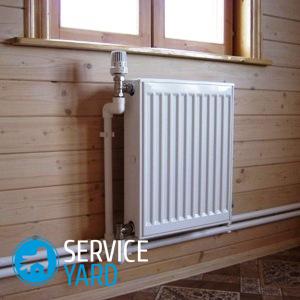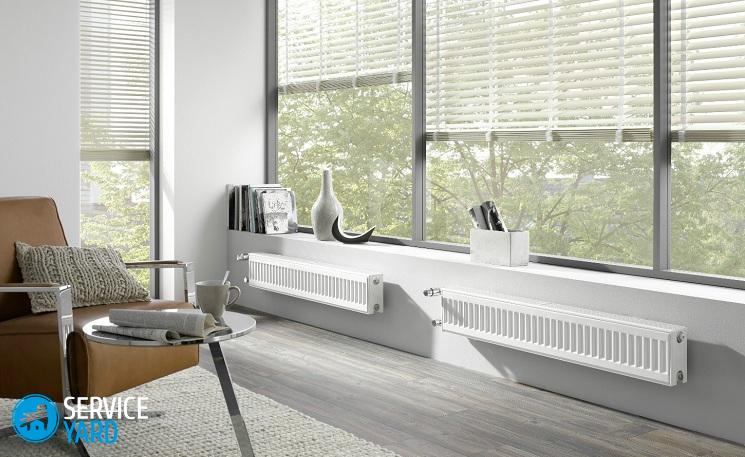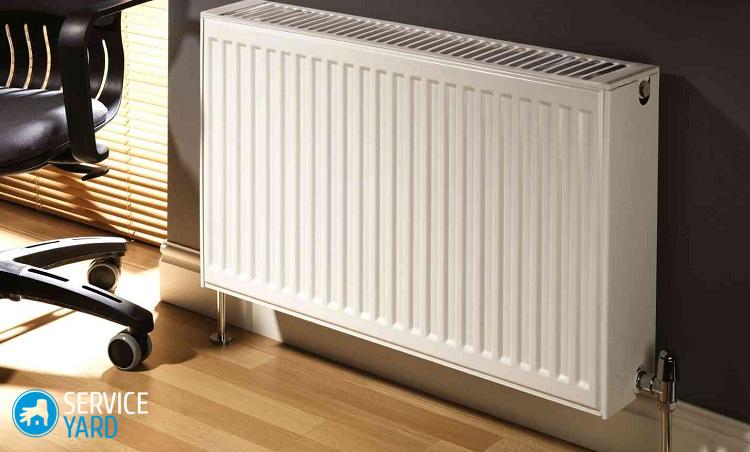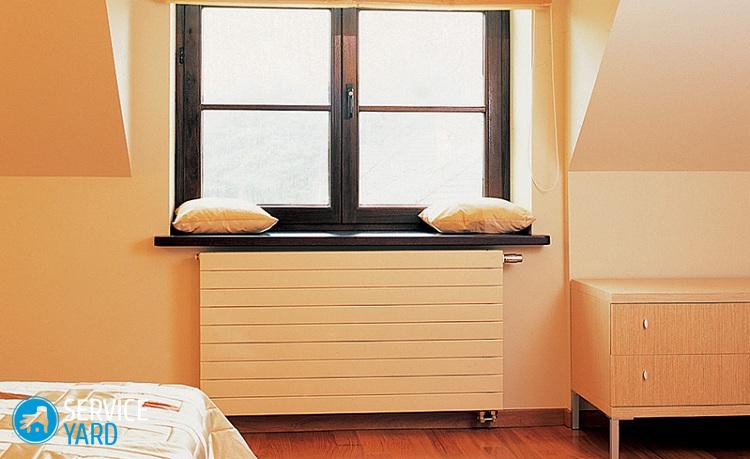How to choose heating radiators for a private house?

One of the most common ways to heat a private house is an autonomous heating system. This method is independent of the central energy source and provides for the possibility of carrying out most installation work independently, without the participation of any specialized services. From this article you will learn how to properly organize the heating system as a whole, as well as how to choose heating radiators for a private house.
to contents ↑Features of the heating system of private houses
Today, not only homeliness, but also the state of the family budget depends on the choice of the type of heating system, as well as on the correct installation of radiators and other components of the structure. In the context of constant growth in energy prices, and also taking into account the global trend of saving natural resources, it is very important to know how to choose the right heating radiators for a private house.
Before you begin installing the heating system of the room, you should decide on its type. There are two main types:
- air;
- water.
In the first case, heating is carried out through solid fuel stoves, as well as using gas convectors, electric radiators, infrared heaters, oil heaters, and in some cases, air conditioners. The room is heated by heating the air in a local, spot way.
The second type of heating involves the forced circulation of the coolant (water or antifreeze) in a closed heating system.
to contents ↑Air heating systems
Let us consider in detail the advantages and disadvantages of some individual heating options by air.
Stove
The furnace heating method is carried out by burning the furnace with both solid fuel and gas. The main advantage of this method when using solid fuel is the saving of finances. In this case, the following can be distinguished from the disadvantages:
- short-term effect of heating the building;
- in winter, the stove needs to be heated several times a day;
- local effect, that is, the house warms up only in adjacent rooms adjacent to the stove;
- continuous control of the combustion process and traction control.
Important! Also, this heating method is characterized by the lowest efficiency and large heat losses. In the case of heating the furnace with natural gas, significant energy costs are also added.
Electric Radiators, IR Heaters
The next version of the air type of heating is more advanced - it involves the use of electricity to heat buildings using electric radiators, infrared heaters and oil convectors.
The main positive feature of this method of heating is the speed of heating due to the power of the devices. But the disadvantages include:
- locality of action of devices;
- not always worthy of efficiency, that is, heat is concentrated only in the field of action and during operation;
- you need a high-quality and powerful power grid.
Gas convectors
Another way of air heating is using a gas convector.The air heats up as it passes through the appliance in which the gas burner is installed, and then the fan pushes the warm air back. The advantages of this method of heating is that with minimal cost of energy, high-quality and fast heating of the room occurs.
to contents ↑Important! The only drawback is that this heating mechanism has a local effect, that is, air heating occurs only in the room where the device is located.
Water heating systems
In our latitudes, the most common type of heating is currently water heating. Its essence is as follows: leaving the heater, which is a gas or solid fuel boiler, the coolant (water or antifreeze for heating systems) circulates through the heating mains (heating pipes) and heats the rooms through heating radiators.
When installing such a heating system, it is important to know how to choose heating radiators for a private house, and also a number of other parameters should be taken into account, such as the type of boiler, pipes and coolant.
The system with a closed circuit and forced circulation of the coolant is by far the most energy efficient.
to contents ↑Important! Using modern double-circuit gas boilers with a built-in circulation pump and horizontal-parallel wiring, provided that correctly selected heating radiators, homeowners manage to save up to 50% of energy resources.
The main parameters of the choice of radiators
Before choosing heating radiators for a private house, you need to consider the following parameters:
- Pressure level inside the system. As a rule, the pressure level inside the system of a private house does not exceed 3 atmospheres. While the pressure of the central heating system is 8 atmospheres. The radiators you choose must have the structural ability to withstand such loads.
- Heat transfer characteristics. Consider that water in comparison with antifreeze has a lower rate of heat transfer. And also it partially boils off over time, therefore, a convenient option should be provided for periodic recharge of the system. Plus, in the event of an emergency stop of the boiler, you must be able to completely drain the water or it will simply freeze in the system, which can lead to pipe rupture.
Important! When using water, rust may occur in some types of batteries, such as aluminum radiators.
- The power of the boiler installed in the house. The reference heat consumption per square meter is 90-125 watts. Based on these indicators, at the initial stage, you can determine the necessary boiler capacity.
Important! When planning heating, it is important to compare the power of the boiler and the type of radiators, as well as the number of sections, so that the "heart" of the system has enough power to heat it, while not overpaying for excess power.
- Thermal efficiency of the structure and its strength - this indicator depends on the material of which the radiator is made. One of the best are cast-iron radiators, which have a high strength indicator, and their heat transfer is 70%.
What material should the radiator be made of?
Before choosing heating batteries for a private house, you need to decide what material they should be made of. The efficiency of the entire heating system largely depends on this parameter, since each metal has its own characteristic thermal conductivity and heat transfer.
Batteries are of the following types:
- cast iron;
- steel;
- aluminum;
- copper;
- bimetallic.
Cast Iron Radiators
This is a classic of the genre. Cast iron batteries were widely used in buildings of the last century. Such a radiator consists of several sections and looks like an accordion.
Important! Cast iron batteries can withstand 9 atmospheres of working pressure and 15 atmospheres of pressure testing.
Advantages of cast-iron radiators:
- They have the largest heat transfer, which is 70%.
- Service life - 50 years or more.
- Use in systems without filtration is allowed.
- They are not afraid of rust and impurities in coolants.
- The possibility of combining a different number of sections.
- Immune to the quality of the coolant.
- Withstand temperatures up to 150 ° C.
- The power of one section is 80-160 watts.
Disadvantages of cast iron radiators:
- A lot of weight.
- Rough appearance, although recently appeared models with an original design.
- High inertia, which is a big minus for autonomous systems with automatic temperature control.
- High price.
- Sensitivity to water hammer.
- It is necessary to color regularly.
Steel radiators
These are one of the best heating radiators for a private house, since they work most efficiently in a low-pressure system and are resistant to corrosion. Pressure indicators: working - 8.7 atmospheres, pressure testing - 13 atmospheres.
Important! If you are faced with the question of how to choose heating radiators for a private house, where very hard water or with a high iron content will be used as the heat carrier, it is better to choose steel batteries.
The main advantages of steel radiators:
- Excellent heat dissipation - 60%.
- Low inertia.
- Low price.
- Light weight.
- Convenient dimensions.
- The temperature limit is 120 ° C.
Disadvantages of steel radiators:
- The need for flushing every three years.
- Inability to resize the battery.
Aluminum radiators
If you are still thinking about how to choose heating batteries for a private home, pay attention to aluminum radiators. They are popular among buyers due to their attractive appearance and acceptable technical parameters. Structurally, aluminum radiators consist of several sections, which are made by casting.
Important! Such batteries withstand 6-15 atmospheres of pressure.
Advantages of aluminum radiators:
- Easy installation.
- You can select the desired number of sections yourself.
- Light weight.
- Beautiful appearance.
- Heat transfer - 50%.
- The temperature limit is 110 ° C.
- The power of one section is up to 200 watts.
Disadvantages of aluminum radiators:
- Sensitive to heating rate.
Important! If the heating system heats up too quickly, the temperature at the top of the aluminum battery will be very different from the bottom. This, in turn, can lead to a radiator malfunction.
- Sensitive to water hammer.
- Demanding on the quality of the coolant.
- Corroded.
Copper radiators
Due to the design and material features, copper batteries are characterized by high heat transfer, which is 85-90%. Pressure indicators: operating - 16 atmospheres, pressure testing - 20 atmospheres.
Advantages of copper radiators:
- Excellent heat dissipation even at low coolant temperature.
- Service life - from 50 years.
- Light weight.
- No reinforced fasteners required.
- Resistant to short-term freezing.
- The maximum temperature of the heat carrier is 250 ° C.
- Insensitive to fluid quality.
- Quick heating of the radiator - up to 3 minutes.
Important! If you are faced with the question of how to choose heating radiators for a private house with a large area, while the cost of energy resources is a critical factor, it makes sense to purchase copper batteries.
Disadvantages of copper radiators:
- Very high price.
- When choosing copper radiators, the connecting pipes of the heating system must also be made of copper.
Bimetal radiators
Radiators of this type are made of two metals. Mainly used is a steel core coated with aluminum.
Important! Such batteries can withstand 35-52 atmospheres of pressure.
Advantages of bimetallic radiators:
- Resistant to water hammer.
- They have an excellent heat transfer rate of 60%.
- Insensitive to pressure changes.
- A small capacity, therefore, such a heating system requires a smaller amount of coolant.
- Low inertia.
- Sectional power - up to 190 watts.
- Attractive appearance.
- Light weight.
Disadvantages of bimetallic radiators:
- High price.
Design features of radiators
If you yourself are studying the topic of how to choose the right heating radiators for a private house, do not forget to take into account such an aspect as design features.
There are 4 types of batteries:
- Tubular. They consist of several tubes that are interconnected by collectors. Such batteries have an interesting design, as well as a large selection of shapes and sizes. But at the same time they are solid, not typesetting.
- Sectional. They are assembled from several separate elements, which are made of various kinds of metals by solid casting. Their feature is that you can independently adjust the size of the radiator.
- Panel. A design of this type has one or more plates between which the coolant circulates through special internal channels. Panel radiators are made only of steel.
- Convector. The design consists of plates mounted on pipes. The coolant circulates only through pipes, which, in turn, already heat the plates.
How to calculate the required number and type of radiators for the home?
Before choosing heating radiators for a private house, experts recommend a calculation that will allow you to choose the best option for your particular case.
Important! The basis is taken as an indicator of the required amount of energy for heating one square meter of living space, which varies from 95 to 125 watts. These figures are standardly calculated for a room with one window and a door with a ceiling height of 3 meters and a coolant temperature of 70 ° C.
When calculating the required number of batteries, it is important to consider the following parameters:
- Ceiling height. It should be the distance from the floor to the ceiling in your house, measured in meters, divided by 3, and then multiply the resulting coefficient by a reference indicator of the required amount of energy to heat one square meter of living space.
- The area of the heated room. To find out the total required power of all radiators, the previously obtained personal parameter should be multiplied by the area of the entire living room.
- Features of the room. When installing batteries in corner rooms, the total heating system should be multiplied by 1.5. The same increase applies if the room has many windows and doors.
- Coolant temperature. The total power of the radiators increases by 15-20% for every 10 ° C of lowering the temperature of the coolant from the reference (70 ° C). That is, if water heating is expected to be at a temperature of 40 ° C, the total heating system indicator in watts should be increased by 45-60%.
Further, in order to find out the required number of batteries or sections for heating the system, it is necessary to divide the calculated calculated necessary power of the entire system by the power of a specific type of radiator or section.
to contents ↑Important! When choosing sections yourself, remember that their number in one radiator, regardless of the design and type of heating system, should not exceed 10 pieces. The efficiency of the “additional” ribs over 10 will be quite low.
Stock footage
In today's review, you learned how to choose the right radiators for a private home. In principle, there is no universal advice on choosing a heating system. Each owner must independently take into account the features of heating, its design, operating conditions and its own financial capabilities. And only an analysis of all these parameters will make the final right choice.
- How to choose a vacuum cleaner taking into account the characteristics of the house and coatings?
- What to look for when choosing a water delivery
- How to quickly create comfort at home - tips for housewives
- How to choose the perfect TV - useful tips
- What to look for when choosing blinds
- What should be running shoes?
- What useful things can you buy in a hardware store
- Iphone 11 pro max review
- Than iPhone is better than Android smartphones






